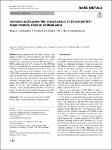Item Infomation
Full metadata record
| DC Field | Value | Language |
|---|---|---|
| dc.contributor.author | Liu, Ming | - |
| dc.contributor.author | Zhu, Jia-Ning | - |
| dc.contributor.author | Popovich, V. A. | - |
| dc.date.accessioned | 2023-08-18T02:05:48Z | - |
| dc.date.available | 2023-08-18T02:05:48Z | - |
| dc.date.issued | 2023 | - |
| dc.identifier.uri | https://link.springer.com/article/10.1007/s12598-023-02329-6 | - |
| dc.identifier.uri | https://dlib.phenikaa-uni.edu.vn/handle/PNK/8827 | - |
| dc.description | CC-BY | vi |
| dc.description.abstract | Electrochemical tests and surface analysis were applied to study the corrosion behavior and passive film characteristics of three-dimensional-printed NiTi shape memory alloys fabricated by laser-powder bed fusion (L-PBF) in artificial saliva at 37 °C. The passivity of L-PBF NiTi shows to be influenced by the process parameters and resulting morphological and physicochemical surface properties. The results show that the defects at the surface of L-PBF NiTi can promote the passivation rate in the early stages of exposure but a slowly formed passive film shows the best corrosion protection. The thickness of the passive film is positively correlated with its corrosion protective performance. The L-PBF NiTi alloy prepared at a linear energy density of 0.2 J·m−1 and volumetric energy density of 56 J·mm−3 shows the least defects and best corrosion protection. An outer Ti-rich and inner Ni-rich dense passive film could be also obtained showing higher corrosion resistance. | vi |
| dc.language.iso | en | vi |
| dc.publisher | Springer | vi |
| dc.subject | L-PBF | vi |
| dc.subject | L-PBF NiTi alloy | vi |
| dc.title | Corrosion and passive film characteristics of 3D-printed NiTi shape memory alloys in artificial saliva | vi |
| dc.type | Book | vi |
| Appears in Collections | ||
| OER - Khoa học Vật liệu, Ứng dụng | ||
Files in This Item:

